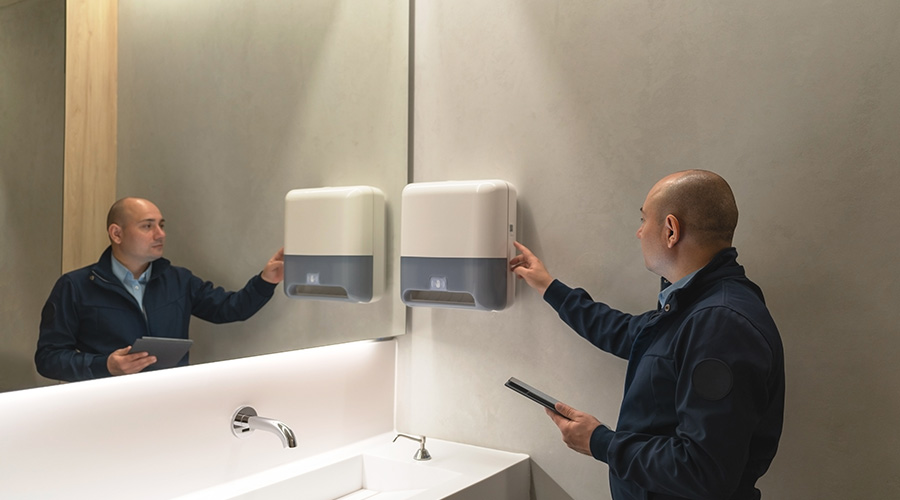Design Considerations For Green Restrooms
Manufacturers advise facility executives to do the research to find the products their facility and organization needs. As an example, Kennedy says that environmental requirements and water consumption should be foremost considerations.
“A 2.2 gpm flow rate is necessary in food preparation areas, nurses’ stations and custodial rooms, for example, where employees are washing foods, filling containers or rinsing equipment,” she says. “But basic hand-washing faucets can operate effectively at a much lower flow rate. The U.S. Green Building Council specifically recommends lavatory faucets with 0.5 gpm outlets for public restrooms and other general hand-washing stations.”
In selecting products, facility executives should also consider factors like the amount of traffic a restroom will have and the characteristics of the maintenance staff that will be responsible for the restroom.
As with all major decisions, facility executives should approach with caution all performance claims. Benchmark prior to making final purchase decisions. When choosing a manufacturer, select one that will stand behind the installation with a performance satisfaction guarantee.
No facility executive wants to install expensive equipment designed to improve efficiency or hygiene standards, only to have it fail to achieve the manufacturer’s claims. At the center of making sure products work as advertised is proper installation and a properly followed maintenance plan.
Another way to maximize product performance is to adjust sensors to the actual restroom. Many sensor products are factory set, but restroom environments can vary in size, shape, and types of users (adults, children, and those in a wheelchair or with other disabilities). And while many sensor products are equipped for manual adjustment and fine-tuning in the field, models using self-adapting technology can eliminate the need for field adjustment.
Education and Prevention
It is also important for facility executives to educate themselves about the maintenance requirements for different product options. For example, a facility executive considering both zero-water-consumption and high efficiency urinals should ask manufacturers for recommended maintenance procedures, so they can make a side-by-side comparison.
With some newer restroom technology, it is important to educate occupants or visitors with signage. For example, with dual-flush toilets, signage can explain the two options for flushing. Placards can inform users of the facility’s effort to conserve water and encourage occupants to take part in the effort.
Finally, manufacturers recommend that facility executives not underestimate the need for durability. That’s because durability is the first line of defense against heavy use and, unfortunately, abuse in the form of vandalism.
While most facility executives likely think of vandalism against sensor-operated fittings, Gettelman also says that toilet partitions usually see a fair share of vandalism, from graffiti to broken door hinges.
For this reason, the company recommends that all restroom equipment, including accessories, toilet partitions and plumbing fixtures, should be chosen based on their engineering performance, material durability, and fabrication to meet the building occupancy needs.
AUTOMATION
Taking Clean Restrooms to the Next Level:
- Automating washroom fixtures is a good start to begin reducing contaminated surfaces.
- Even with automated fixtures, keeping toilets and urinals clean and sanitary is also important. Automatic cleaning systems provide round-the-clock cleaning, while controlling cleaning supply and labor costs.
- Improving the frequency of hand washing and surface cleaning is critical. Studies have shown that high quality soap and automated soap systems encourage people to wash their hands more frequently. Keeping employees healthy within an organization both boosts productivity and morale.
|
Loren Snyder, a contributing editor for Building Operating Management, is a writer who specializes in facility issues. He was formerly managing editor of Building Operating Management.
Related Topics:














